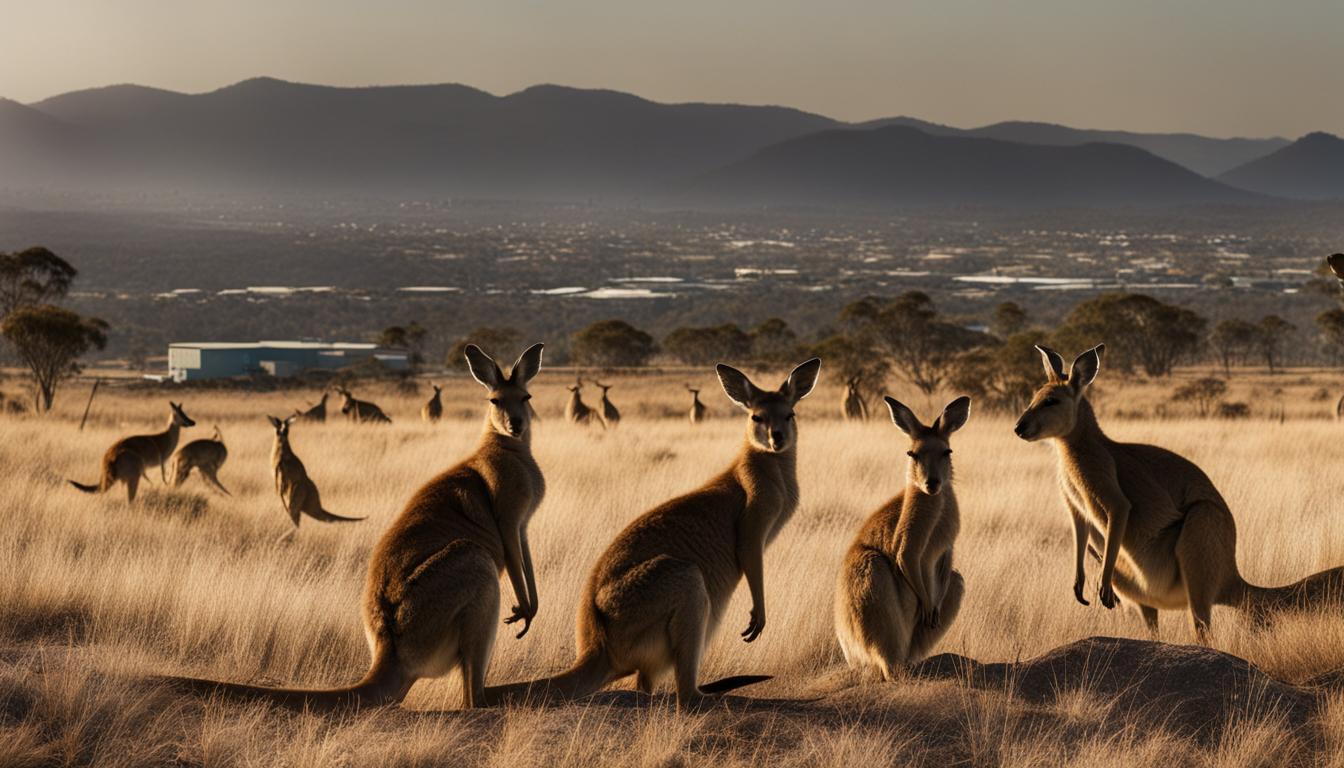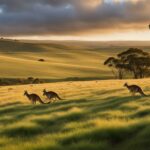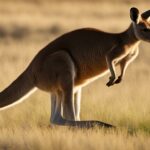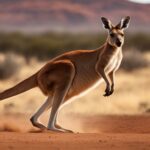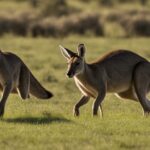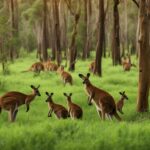Kangaroos, iconic creatures of the Australian outback, are facing numerous threats to their survival in the wild. From habitat loss and climate change to human-wildlife conflicts and hunting, these challenges pose a significant risk to kangaroo populations. Understanding these threats is crucial for effective kangaroo conservation efforts.
As kangaroos continue to face habitat loss and fragmentation, their natural homes are being destroyed and divided. This leads to reduced food and water availability, increased competition for resources, and higher rates of predation. Climate change further exacerbates the situation, with rising temperatures and changing weather patterns causing drier environments and reduced resources for kangaroos.
Human-wildlife conflicts pose another significant threat to kangaroos. As human populations grow, encounters between humans and kangaroos become more frequent. Urbanization and road building disrupt kangaroo habitats, resulting in injuries or fatalities due to vehicle collisions. Coexistence and measures to reduce conflicts are crucial.
Hunting and poaching also take a toll on kangaroo populations. Commercial hunting for meat and skins, as well as illegal poaching, disrupts the natural balance and can lead to population decline. Legislation, regulation of hunting practices, and the promotion of kangaroo conservation are essential to protect these unique creatures.
Disease outbreaks and parasites can have detrimental effects on kangaroo populations, especially with the favorable environments provided by climate change. Monitoring, managing outbreaks, and controlling parasite populations are crucial for kangaroo health and survival.
Kangaroos often compete with livestock for food and resources, leading to conflicts with agricultural practices. Proper land management practices and minimizing competition between kangaroos and livestock are essential for preserving kangaroo populations and supporting sustainable agriculture.
Despite these threats, there is hope for the future of kangaroo populations in Australia. Conservation efforts, such as habitat restoration, land-use planning, and regulation of hunting practices, are already in place. By raising awareness and taking collective action, we can protect these unique creatures and ensure their survival for generations to come.
Habitat Loss and Fragmentation
Kangaroo populations are facing significant threats due to habitat loss and fragmentation. Human activities, such as urbanization, agriculture, and mining, have led to the destruction and fragmentation of kangaroo habitats, resulting in a decline in their population. The destruction of kangaroo habitats reduces the available land for kangaroos to live on, limiting their access to food and water sources and increasing competition for resources.
Table:
| Threats | Impact on Kangaroos |
|---|---|
| Habitat loss | Reduces available land for kangaroos, limits access to food and water sources |
| Fragmentation | Increases competition for resources, higher rates of predation |
Fragmentation of kangaroo habitats also leads to an increase in predation rates. With fragmented habitats, kangaroos have limited areas to seek shelter and are more vulnerable to predators. This further contributes to the decline in kangaroo populations.
“The destruction and fragmentation of kangaroo habitats are significant threats to their survival. It is crucial to address these issues and protect their habitats to ensure the continued existence of kangaroos in the wild.”
The Importance of Protecting Kangaroo Habitats
To mitigate the impact of habitat loss and fragmentation on kangaroo populations, it is essential to implement conservation measures that focus on protecting their habitats. This can be achieved through habitat restoration efforts that aim to reclaim destroyed areas and create wildlife corridors to connect fragmented habitats.
By protecting and restoring kangaroo habitats, we can provide them with the necessary resources for survival, reduce competition with livestock, and enhance their overall population health. It is crucial to prioritize the conservation of kangaroo habitats to ensure the long-term survival of these iconic Australian marsupials.
Climate Change and Its Impact on Kangaroos
Climate change is a pressing issue affecting not only humans but also wildlife populations, including kangaroos. The rising temperatures and changing weather patterns have significant impacts on kangaroo habitats and their overall survival. The consequences of climate change are far-reaching and pose numerous challenges for kangaroos and their ecosystems.
One of the primary impacts of climate change on kangaroos is habitat loss. As temperatures rise and weather patterns shift, many regions experience increased aridity and reduced rainfall. These changes lead to the loss of vegetation and water sources, making it difficult for kangaroos to find adequate food and water. The reduction in available resources can result in weakened individuals, reduced reproductive success, and ultimately population decline.
Furthermore, climate change alters the timing and availability of food sources, disrupting the delicate balance of kangaroo diets. Kangaroos rely on specific plants and grasses for their nutrition, and any changes in vegetation patterns can affect their ability to find suitable food. This disruption in food availability also impacts other aspects of their lives, such as breeding patterns and migration behavior.
The Impact of Climate Change on Kangaroo Breeding
The breeding patterns of kangaroos are closely tied to environmental cues, including temperature and rainfall patterns. With climate change, these cues become less predictable and can lead to mismatches in breeding cycles. For example, if there is a delay in rainfall, vegetation growth may be delayed as well, impacting the availability of resources needed for successful reproduction. Additionally, extreme weather events such as droughts or heatwaves can further stress kangaroos, affecting their reproductive capacity.
Overall, the effects of climate change on kangaroos are complex and interconnected. To mitigate these impacts, it is crucial to address the root causes of climate change by reducing greenhouse gas emissions and promoting sustainable practices. Additionally, efforts should be made to protect and restore kangaroo habitats to ensure their resilience in the face of a changing climate. Conservation measures, such as creating wildlife corridors and implementing strict hunting regulations, also play a vital role in safeguarding kangaroo populations and their ecosystems.
| Effects of Climate Change on Kangaroos | Summary |
|---|---|
| Habitat Loss | Rising temperatures and changing weather patterns lead to habitat loss, reducing food and water availability for kangaroos. |
| Disrupted Breeding Patterns | Climate change can cause mismatches in breeding cycles due to unpredictable environmental cues. |
| Altered Food Availability | Changes in vegetation patterns affect kangaroo diets, impacting their overall health and reproductive success. |
| Increased Vulnerability | Kangaroos become more susceptible to extreme weather events, such as droughts and heatwaves, which can lead to population decline. |
Human-Wildlife Conflicts
Human-wildlife conflicts are a significant threat to kangaroo populations. As human populations continue to grow, the encounters between humans and kangaroos increase, leading to conflicts that can have detrimental effects on both parties involved. Activities such as urbanization and road building can disrupt kangaroo habitats and result in injuries or fatalities due to vehicle collisions.
It is important to raise awareness about the importance of coexistence between humans and kangaroos. By implementing measures to reduce these conflicts, we can create a safer environment for both species. This includes educating people about kangaroo behavior, implementing wildlife-friendly road infrastructure, and developing strategies to minimize habitat disturbance.
“We must work together to find solutions that allow kangaroos and humans to share the same space harmoniously.” – Dr. Jane Cooper, Wildlife Conservationist
Efforts to mitigate human-wildlife conflicts should also involve community engagement and collaboration. Encouraging responsible behavior, such as not feeding or approaching kangaroos, can help reduce negative interactions. Additionally, establishing protected areas and wildlife corridors can provide safe spaces for kangaroos to thrive while minimizing encounters with humans.
| Actions to Reduce Human-Wildlife Conflicts | Benefits |
|---|---|
| Education and awareness campaigns | Increased understanding of kangaroo behavior and reduced human interventions |
| Wildlife-friendly road infrastructure | Reduced vehicle collisions and injuries to kangaroos |
| Community engagement and responsible behavior promotion | Minimized negative interactions between humans and kangaroos |
| Establishment of protected areas and wildlife corridors | Safe spaces for kangaroos to thrive while minimizing human encounters |
By addressing human-wildlife conflicts, we can help protect kangaroos and ensure their long-term survival in their natural habitats. It is crucial to find a balance that allows both humans and kangaroos to coexist harmoniously, respecting the needs and behaviors of these iconic Australian creatures.

Hunting and Poaching
Kangaroo hunting and poaching pose significant threats to the survival of kangaroo populations. Commercial hunting for kangaroo meat and skins, as well as illegal poaching, have led to a decline in kangaroo numbers and disrupted the natural balance of ecosystems.
In Australia, kangaroo hunting is regulated and managed through quotas and licensing systems. However, concerns remain about the sustainability and ethics of this practice. While kangaroo meat is considered a lean and healthy protein source, the scale of commercial hunting raises questions about the impact on kangaroo populations and their welfare. Illegal poaching adds to the pressure on kangaroo populations and undermines conservation efforts.
Protecting kangaroos from the threats of hunting and poaching requires a multi-faceted approach. Strict regulation and enforcement of hunting practices are essential to ensure that hunting is sustainable and does not harm kangaroo populations. Compliance with quotas, licensing, and ethical hunting standards should be closely monitored and enforced to prevent over-harvesting and unnecessary cruelty.
Conservation organizations and government agencies also play a crucial role in educating the public about the importance of protecting kangaroos and promoting alternative ways to coexist with these iconic animals. Raising awareness about the threats facing kangaroos and the benefits of conservation is vital for fostering a sense of responsibility and encouraging sustainable practices.
| Threat | Impact | Solution |
|---|---|---|
| Commercial hunting for kangaroo meat and skins | Population decline, disruption of ecosystems | Strict regulation, monitoring of hunting practices |
| Illegal poaching | Further decline in kangaroo populations | Enhanced enforcement, public education |
Kangaroo Diseases and Parasites
Kangaroos are not only threatened by habitat loss and climate change but also by various diseases and parasites that can have a detrimental impact on their populations. Understanding and managing these health issues are crucial for the conservation and protection of kangaroos in the wild.
One common disease that affects kangaroos is toxoplasmosis, caused by the parasite Toxoplasma gondii. Kangaroos can contract this disease through the ingestion of contaminated food or water. Toxoplasmosis can lead to severe illness and even death in kangaroos, making it a significant concern for their population. Additionally, kangaroos are susceptible to other infectious diseases such as pneumonia and tuberculosis.
Parasites also pose a threat to kangaroo health. Parasitic infections, such as ticks and worms, can weaken kangaroos and make them more vulnerable to other diseases. Ticks are particularly problematic as they can transmit diseases and cause anemia in kangaroos. These parasites can have a negative impact on kangaroo survival rates and overall population well-being.
Efforts are underway to monitor and manage disease outbreaks and control parasite populations in kangaroo habitats. Research and surveillance programs help identify and understand the prevalence and impact of diseases and parasites on kangaroo populations. This knowledge informs the development of targeted interventions, such as vaccination programs and parasite control strategies, to mitigate the spread and impact of these health threats.
| Disease | Impact on Kangaroos |
|---|---|
| Toxoplasmosis | Severe illness and death |
| Pneumonia | Increased susceptibility to respiratory infections |
| Tuberculosis | Chronic illness and weakened immune system |
| Ticks | Disease transmission and anemia |
| Worms | Weakness and increased vulnerability to diseases |
By addressing the threats posed by diseases and parasites, conservation efforts can enhance the overall health and resilience of kangaroo populations. Protecting kangaroos from these health risks contributes to their long-term survival and supports the conservation of Australia’s unique wildlife.
Competition with Livestock
Kangaroos often find themselves in competition with livestock for food and resources. As both kangaroos and livestock graze on the same land, conflicts can arise, especially in agricultural areas where the available grazing land is limited. This competition can have significant impacts on both kangaroo populations and the agricultural industry.
One of the main challenges of kangaroo-livestock competition is the difference in grazing behavior. Kangaroos tend to be more selective grazers, favoring certain types of vegetation, while livestock, such as cattle and sheep, have a broader diet. This can lead to overgrazing and depletion of resources, impacting the overall productivity of the land.
To address this issue, proper land management practices are crucial. Implementing rotational grazing systems, where kangaroos and livestock are managed separately in different areas, can help reduce competition and allow for the recovery of vegetation. Fencing can also be used to create exclusion zones, ensuring that certain areas are dedicated solely to kangaroo grazing.
Table: Comparison of Kangaroo and Livestock Grazing Behavior
| Grazing Behavior | Kangaroos | Livestock |
|---|---|---|
| Feeding Preferences | Selective grazing, favoring certain types of vegetation | Broader diet, grazing on a wider range of vegetation |
| Grazing Patterns | Moving in small groups, covering larger areas | Forming larger herds, grazing intensively in specific areas |
| Impact on Vegetation | Can lead to selective depletion of certain plant species | May cause more uniform grazing and greater overall vegetation consumption |
| Resource Competition | May compete for limited food and water resources | May compete for limited food, water, and grazing space |
By finding ways to minimize competition between kangaroos and livestock, it is possible to support both sustainable agricultural practices and the preservation of kangaroo populations. This can be achieved through a combination of effective land management, sustainable grazing practices, and ongoing dialogue and collaboration between farmers, conservationists, and government agencies.
Conservation Efforts and Hope for the Future
Protecting kangaroos from the threats they face is a key priority for conservation efforts. Various strategies have been implemented to safeguard kangaroo populations and their habitats. One important approach is habitat restoration, which aims to reverse the damage caused by human activities such as urbanization and agriculture. By restoring and protecting their natural habitats, we can provide kangaroos with the necessary resources for survival.
Land-use planning is another crucial aspect of kangaroo conservation. By carefully managing the allocation of land, we can ensure that kangaroos have sufficient space to roam and thrive. This includes creating wildlife corridors, which enable safe passage for kangaroos between fragmented habitats. These corridors play a vital role in maintaining genetic diversity and promoting healthy populations.
Regulating hunting practices is also essential for protecting kangaroos. By enforcing legislation against poaching and establishing sustainable hunting quotas, we can prevent overexploitation and ensure the long-term survival of kangaroo populations. It is crucial to raise awareness about the importance of responsible hunting and the value of kangaroos as integral members of the ecosystem.
There is hope for the future of kangaroo populations in Australia. With continued support for conservation efforts and a collective commitment to their protection, we can make a positive impact on their survival. By working together, we can safeguard these iconic and unique creatures for generations to come.
FAQ
What are the primary threats facing wild kangaroo populations?
The primary threats facing wild kangaroo populations include habitat loss and fragmentation, climate change, human-wildlife conflicts, hunting and poaching, disease outbreaks and parasites, competition with livestock, and invasive species and kangaroo predators.
How does habitat loss and fragmentation affect kangaroo populations?
Habitat loss and fragmentation reduce the available land for kangaroos to live on, leading to reduced food and water availability, increased competition for resources, and higher rates of predation.
What impact does climate change have on kangaroos?
Climate change leads to habitat loss, drier environments, reduced food and water availability, changes in breeding patterns, and increased susceptibility to diseases for kangaroos.
What are human-wildlife conflicts and how do they affect kangaroos?
Human-wildlife conflicts occur when encounters between humans and kangaroos increase, resulting in disruptions to kangaroo habitats, injuries or fatalities due to vehicle collisions, and competition for resources.
How do hunting and poaching pose threats to kangaroo populations?
Commercial hunting for kangaroo meat and skins, as well as illegal poaching, can lead to population decline and disruption of the natural balance in kangaroo populations.
What are the impacts of disease outbreaks and parasites on kangaroos?
Disease outbreaks and parasites are detrimental to kangaroo populations, as warmer temperatures and drier conditions caused by climate change provide favorable environments for the breeding of diseases and parasites.
How do kangaroos compete with livestock?
Kangaroos often compete with livestock for food and resources, which can lead to conflicts with agricultural practices where kangaroos and livestock share the same grazing land.
What conservation efforts are in place to protect kangaroos?
Conservation efforts include habitat restoration, land-use planning, the creation of wildlife corridors, and the regulation of hunting practices to protect kangaroo populations.
Is there hope for the future of kangaroo populations?
With collective action and commitment to conservation efforts, there is hope for the future of kangaroo populations in Australia.

